|
Monday, May 4, 2009
Progress Notes
The Miller County Historical Society held its members’ potluck dinner April 16 in the new addition’s dining and exhibit area of the lower floor (photo 01).
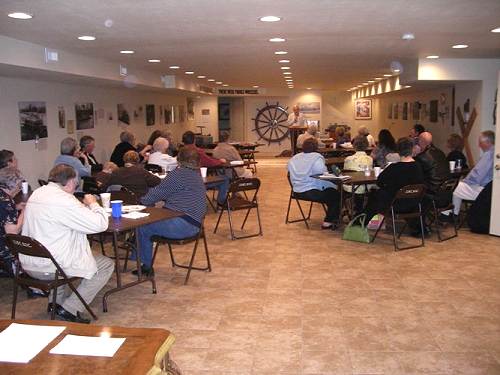
01 MCHS Members Here is a summary of the meeting as written by Peggy Hake, Secretary of our Association:
Members and guests of the Miller County Historical Society met at the museum on Sunday, April 19. Several were in attendance and a carry-in luncheon was shared by all at one p.m.
President Joe Pryor conducted the business meeting following the dinner. He announced the upcoming events that are scheduled for the historical society during the summer and fall months including a grand re-opening to be held on Saturday, May 16; quilt show in June; the annual ice cream social which is scheduled for July and an old car show & chili dinner in October.
April is the month for the general election of officers and board members. The following were presented as a slate to be voted for and all were accepted on a motion and vote of acclamation..... President: Joe Pryor, Sunrise Beach; Vice President: Carl McDonald, Jefferson City; Secretary: Peggy Hake, St. Elizabeth; Treasurer: Betty Kallenbach, Eldon. Two board members were elected to serve for 3 year terms: Connie Prather, Iberia; and Jack Brumley, Tuscumbia.
Special speaker for the day was Dwight Weaver of the Lake area, a member of the historical society and the museum committee, who spoke about his books that he has written over a period of several years. Some concern his interest in caves in the state of Missouri and the others are books he has written about the Lake of the Ozarks region. His books are available in the gift shop at the society's museum in Tuscumbia. He has written books about the Mark Twain Cave near Hannibal, Meramac Caverns, and Ononadaga Cave in central Missouri.
The next event the historical society will sponsor will be the special grand re-opening of the museum which will be held on Saturday, May 16, with a number of events to be held on the museum grounds including local music and talent, taffy pulling contests, a flag dedication, and a presentation of the old church bell from Tuscumbia's Presbyterian Church which was given back to the historical society by the College of the Ozarks at Branson. Local and national dignitaries will be on hand at the dedication.
As noted by Peggy, Jack Brumley of Tuscumbia and Connie Prather of Iberia were elected by the members to be board representatives. I had known Jack a long time ago when we attended Tuscumbia High School. Jack was one of the star basketball players of teams which consistently had winning records during his years of play. He has been a school administrator for many years including more than twenty at the Russellville School system where he was superintendent for five years. Later, after joining the State Department of Education he became an area supervisor. On retirement Jack was awarded the very prestigious Pioneer In Education Award from the department. Presently, Jack serves on the board of the Tuscumbia Fire Department and the board of the Bank of Russellville. Locally, the Tuscumbia community was very appreciative of his willingness a few years ago to serve as Superintendent of The Tuscumbia School system for three years during a transition period while the board was seeking a candidate to assume the position permanently.
Connie, who is from Iberia, is well known for the many years she owned and operated D’Best Trophies shop. Also, she is a member of several community service organizations including the American Legion, Elks Lodge, Crocker VFW, Masonic 7 organization, and the Red Hats group. Her husband, Bill Prather, was actively involved in the insurance business having been the one who started the Shelter Insurance Company of Iberia.
We are very fortunate to have board members of the quality of Jack and Connie.
Also as recorded by Peggy, Society member Dwight Weaver presented a talk about his six books written about Missouri and Miller County caves. In addition he discussed the four books he has written about the history of the early tourist industry of the Lake of the Ozarks, and in particular about the Miller County recreational corridor. Dwight is quite famous for having the most extensive collection of vintage photographs of the Lake area, and his books are replete with many examples of his photographic history of the Lake. Afterward, Dwight spent the afternoon signing books bought by quite a few of the members attending the meeting (photo 02).
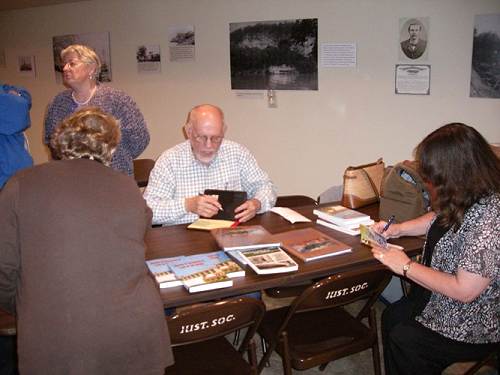
02 Dwight Weaver signing Books Dwight’s book sales the other day certainly added a significant amount of income to our Society bank account and we are very appreciative of his generosity in helping support us in this manner.
We had some interesting guests at the meeting. Marianne Dennie came to discuss with us the art of Quilling. Marianne will be participating in our craft festival at the Grand Reopening on Saturday, May 16 at which time she will be demonstrating this fascinating Renaissance Period art form. As a teaser she brought an example of her work (photo 03).
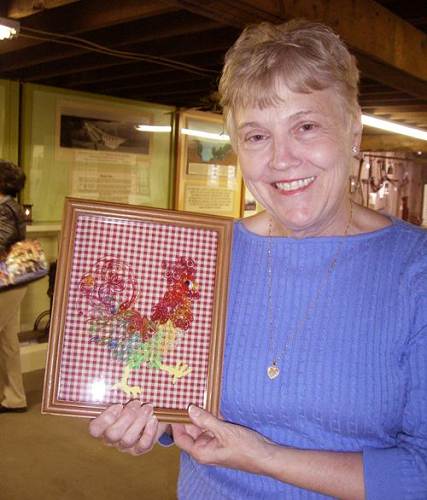
03 Marianne Dennie Also, Marianne provided this brief history of this type of hand craft:
Welcome to the World of Quilling
For those of you who are just being introduced to the delicate and yet fascinating art of quilling, you may appreciate knowing some of the background of this art.
The Renaissance period is said to have begun in Italy in the middle of the 15th century with the invention of printing. The Renaissance did not have a sudden beginning or end, but during the expanse of the next two centuries this period brought with it a rebirth in the interests of arts and learning and development of trade. Thus, the 17th century brought to light a new decorative art called quilling, said to have been created by the Italian nuns. From that time, quilling, as did many other arts, spread into France, England, and other parts of Europe, and ultimately into pre-Revolutionary Colonial America.
Quilling was first used by the Italian and French nuns in creating exquisite designs to decorate religious artifacts and the walls of churches. As the art form spread to new parts of the world, it was fashionable for the ladies of the 17th and 18th centuries to create beautiful and delicate edgings on folding screens, fire screens, mirrors, boxes, and pieces of furniture, with quillwork.
The methods used in forming the varied designs in quillwork have not changed; however, the hatpin has replaced the quill point as the tool used in yesteryear. In the 17th century, very narrow strips of paper were cut from gilt edged books and vellum paper, whereas the 20th century has made available pre cut strips of paper in a vast array of colors found in many craft shops (photo 04).

04 Hat Pin and Quilling Paper When creating a quilling design, you will have a sense of satisfaction and joy in knowing that you are bringing an art form of the old world into the present day for yourself and others to enjoy.
So be sure to come to the museum May 16 to see Marianne and other craft workers demonstrate their artful skills.
Another interesting couple who came to our meeting last week were Layne Hicks (photo 05) and his mother, Pauline Jones Hicks (photo 06).
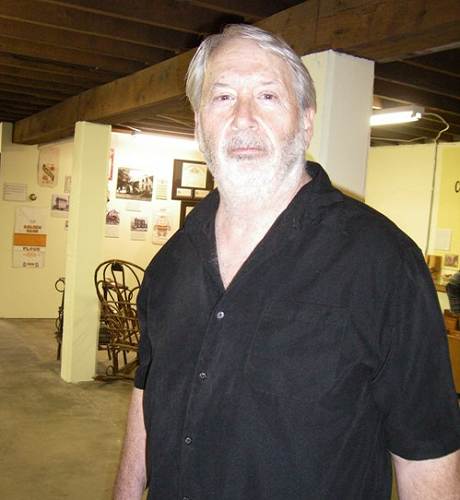
05 Layne Hicks
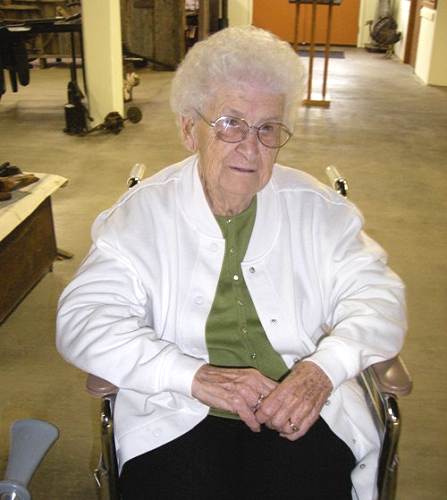
06 Pauline Jones Hicks Pauline is originally from Iberia although she spent quite a few years in the St. Louis area where her son Layne was raised. Pauline now has returned to this area and is living in Iberia. She attended the Johnson School as a child and her son, Layne, has created a pencil drawing of the old school. He was kind enough to have brought it along with him to the meeting and I took a picture of it for all to see (photo 07).
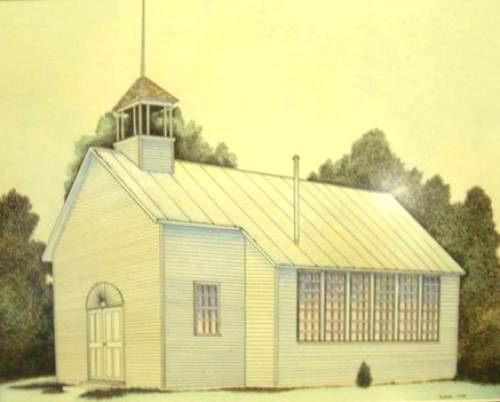
07 Johnson School We have a brief history and interesting comments about the Johnson school on our own website at this URL:
http://www.millercountymuseum.org/schools/orsp.html
I will copy here what we have recorded about the school:
School Information:
The Johnson School house was sold at auction August 27, 1960 to become a home. October 29, 1960, a former pupil, Earl Prater, who had purchased the bell, rang the bell at 10 a.m. 50 strokes, one for each year of service before dismantling began. The bell was removed to Earl's Kansas home. The belfry also was taken down and moved to the home of another pupil, Mrs. Clara Carroll Moss of Dixon.
After serving mankind for 98 years, on January 12, 1974, somehow a small fire originated during the night causing the building to burn to the ground. The family living there when it burned was Mr. and Mrs. Kenneth Miller. They escaped leaving their belongings behind. The Millers moved a mobile home to the property to serve as their home.
Letter from Guy Prater to the New Iberian in 1982:
|
I want to write about the Johnston School District #82 that I graduated from in 1909, was a rather large building for those days. There was a small library but few books. There was a large old pot belly stove in the middle of the school room that we all gathered around in cold weather.
The first subject in the morning was history for the older ones and reading for the little ones. Grammar was always my hardest subject.
I think the highest attendance at one time was eighty-one and only for a short time in about 1907. What a job for a teacher in a one room school. We had a bell that could be heard for miles around. When the bell rant at eight-thirty, I knew that it was time to hustle off to school as I had about two miles to walk to school.
I remember an incident that happened along about 1906 when the big boys became unhappy with the teacher and refused to be disciplined and spent most of their time on the school ground playing Base, Leap Frog, Broad Jumping and the like. Things suddenly got worse and the teacher locked the door to keep the boys out and that was when things began to happen. Some of the big boys came in thru the windows to unlock the door to let the older boys in and one came swinging his knife and threatening the teacher and the teacher made a wild swing at him with the big stove poker and hit the upper door facing leaving the imprint in the wood over the door and about that time some of the big boys managed to calm the fellow with the knife and the teacher retired to the middle of the room so after awhile the boys quieted down and went outside. We smaller kids, still excited, were told to continue with our regular studies.
The next morning the school directors were there and a new teacher. The directors departed and the big bell told all to come inside. I remember that all was quiet as the new teacher began to explain that he had been hired to teach the school for the remainder of the term. He addressed the smaller ones first, saying, "You all look cheerful and eager to learn. I will help you all I can. Then he spoke to the big boys and said with a big smile, "Now you big boys can do as you please. After a long pause, as if he was searching their thoughts, he said, "As long as you please to do what is right." Then in a stern voice he said, "I have been hired to teach this school and let there be no mistake, I am going to teach it." And with those words he walked to the library and produced a big hickory about three and a half feet long and he talked and looked at each one and I am sure they felt he was talking to each one personally. HE assured them that he would help them in any way he could.
He finished his talk as he walked back to the library and placed the big hickory on the top shelf. Then with a smile and a glance around the school room he said, "Those are my remarks for the day." He tapped the bell for study period and the entire school began the day.
If my memory is correct all went well and we had a good school with no trouble of any kind. After graduation from the eighth grade I went on to finish my education at the Iberia Academy. In my store room of memories there will always be a Johnson School.
|
Pauline Jones Hicks family history is interesting. Her great grandfather was Manessah Jones (photo 08) and her grandfather was known as Manessah T. Jones.
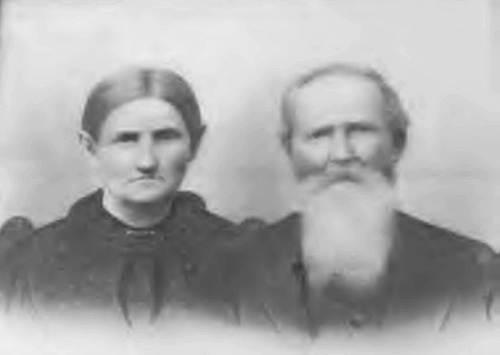
08 Manessah and Margaret Jones Peggy Hake has researched this branch of the Iberia Jones family as follows:
Manessah Jones was a farmer and a Judge of the Miller County
Court in the 1880s. He was a native of Kentucky, born in the “Blue Grass State” in 1838. His parents were Martin and Lucy (Wilson) Jones and both were born in Virginia. Martin was born c/1787 and moved to Kentucky when 7 years old and lived there for many years through childhood and onward into his adult life. He married Lucy Wilson in Kentucky. She died in the late 1830s and Martin married the second time, and in 1860, moved to Illinois. His large family, consisting of 15 children by his two marriages, were reared principally in Kentucky.
The grandfather of Manessah Jones was Philip Jones, a farmer by occupation and he also served as a soldier in the Revolutionary War. Manessah spent his early life in Kentucky and at the age of 19, began working as a farm hand. In 1864, he married Margaret Poynter, who was a native of Kentucky, born in 1834 and was a daughter of Mason and Nancy T. (Bird) Poynter. Her brothers and sisters included Sue J., Julia Ann, William Berry, Franklin, Matilda, John, and Nancy W.
Soon after Margaret married Manessah, they moved to Illinois and were engaged in farming there also. He owned an excellent farm of 210 acres (100 acres under cultivation). He was a Republican in his politics and cast his first Presidential vote for Abraham Lincoln in 1860.
In 1862, Manessah enlisted in Co. C, 98th Infantry of Illinois and was a Corporal under Capt. Cranken Wiley’s Brigade. He was at the battles of Hoover’s Gap, Chickamauga, and with General Sherman on his march to the sea. He also fought at Selma, Alabama. He received his discharge at Nashville, Tennessee and in 1865, returned back to his home in Illinois.
After he moved to the Iberia area, he became a very active member of the G.A.R. (Grand Army of the Republic) and he also belonged to the I.O.O.F. (Independent Order of Odd Fellows). He and his wife were members of the Congregational Church at Iberia. In 1886, he was elected on the Republican ticket as Judge of the Miller County Court, which position he held for two years.
They were parents of 10 children:
NANCY J. JONES,
JOHN F. JONES,
MARTIN A. JONES,
MANESSAH T. JONES,
O.A. MACK JONES,
MARY E. JONES,
GEORGE JONES,
WILLIAM JONES,
NATHAN JONES and
ASSENITH JONES.
Manessah and Margaret (Poynter) Jones have many descendants living in the Miller County area today.
NOTE: Some of this information was given me by David Jones of Sorocco, New Mexico who was a grandson of Manessah and Margaret and the son of John F. Jones. I had a nice visit with David several years before his death when he came back to Iberia to visit relatives and old friends around Iberia. He was very knowledgeable about his Jones family.
Only two days after the Potluck Members’ Meeting described above, the Miller County Historical Society board met April 21, 2009 to plan the events for the upcoming Grand Reopening day on May 16. The event will include many demonstrations and exhibits on the grounds outside the museum as well as demonstrations and new displays inside the building. Music will be provided by Joe Jeffries and his group to include much in the way of traditional hill country string band songs. We are fortunate to be honored by several speakers including County Commissioner, Tom Wright, State Representative, Rodney Schad, State Senator Carl Vogel, and U.S. Representative, Blaine Leutkemyer.
Special events will include the official ringing of the old Presbyterian Church bell returned to the Tuscumbia community by College of the Ozarks last December. You can read more about that on a previous Progress Notes of 8 December 2008.
The bell has been repainted and placed in a sturdy frame supported on special concrete platform all of which was accomplished by the skilled work of board member, Jim Clark (photo 09).
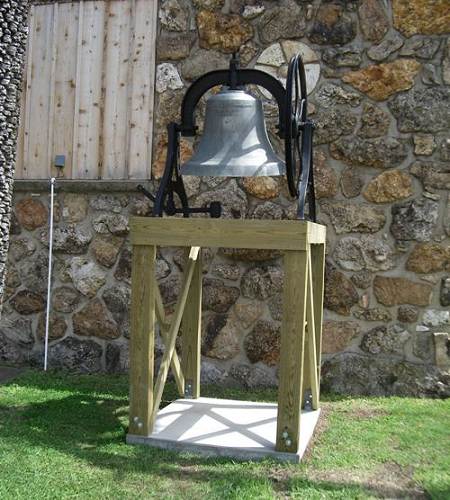
09 Presbyterian Church Bell In addition, due to the generosity of the Kallenbach family, we will have a new flag pole and flag. The hole was dug for the flag pole just a week ago (photo 10).
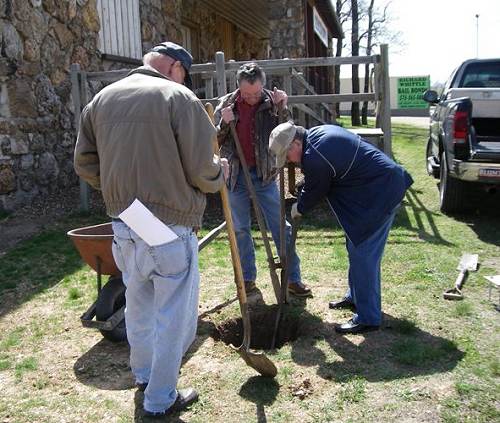
10 Brice Kallenbach, Jim Clark and Carl McDonald digging Flag Pole Hole Betty Kallenbach arranged with Representative Schad to obtain for us the flags which will be both state and national. To introduce the flag we will have a special flag raising ceremony.
Here is a photo of some of those attending the April 21, 2009 meeting: Joe Pryor, Brice Kallenbach, Karen Smith, Connie Prather, Jim Clark, Carl McDonald, and Jack Brumley (photo 11).
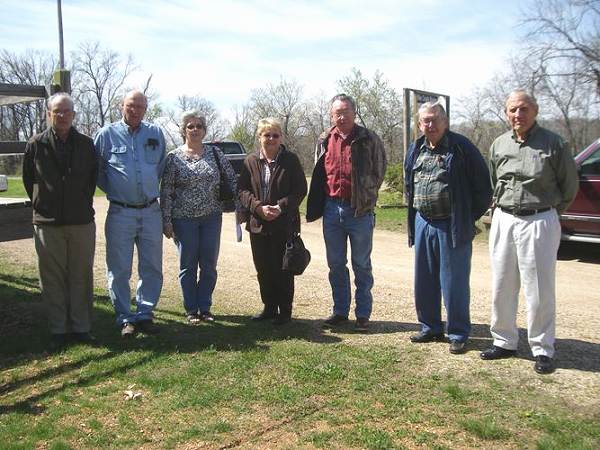
11 Joe Pryor, Brice Kallenbach, Karen Smith, Connie Prather, Jim Clark, Carl McDonald and Jack Brumley Connie and Jack are new board members. We are very grateful that they have consented to donate their time and work to helping us at the museum for the next three years.
I received the following letter from Pastor Greg McClain of the Iberia Church of the Nazarene recently:
Dear Mr. Pryor,
First, let me say how much I truly enjoy the Historical Society's website.
Having moved here to Pastor the Nazarene church 4 years ago, it has been a valuable resource for learning the story of the people to whom God has called me to minister. The hard work and dedication of yourself and other society members is evident on every page. I have a great passion and love for local history so the project to convert the Old City Jail into a Prayer Chapel has been a wonderful experience. From the beginning we have desired to maintain the historical legacy of the building while at the same time, enabling it to serve the people once again in an even greater capacity. I trust you will agree that our desire has been met. Because the Miller County Historical Society website already includes the jail as a Landmark I thought it would be appropriate to pass along the attached article and photographs. The article ran in the April 2nd edition of the Autogram-Sentinel and the pictures chronicle the conversion project.
Thanks for your time and keep up the great work.
In Christ,
Pastor Greg McClain
Iberia, MO Church of the Nazarene
|
The news about the conversion (no pun intended!) of the old Iberia Jail was recorded in several local newspapers. This article was from the Autogram:
OLD CITY JAIL GETS NEW MISSION
“It was Iberia's first jail and was constructed circa 1908 by William Harrison Smith and his sons, Henry Franklin Smith and Phelix Wesley Smith.” --Peggy Smith Hake
So begins the story of an obscure little “tomb-like” structure on Main Street in the heart of Iberia. For over one hundred years the Old Iberia City Jail has stood through every season, well outlasting its 45 year run as provider of room and board for anyone wishing to violate the laws of the land. On Palm Sunday, April 5th, 2009 a new chapter began for the old jail when it was dedicated as the Iberia Community Prayer Chapel.
The Iberia Church of the Nazarene, which owns the jail and on whose property the jail sits, has overseen a lengthy effort to renovate the jail and convert it into a place suitable for prayer and meditation. Various individuals have sacrificed time, talent and treasure to see the project completed. It is the congregation’s hope that the new Iberia Community Prayer Chapel will, as the plaque reads, “become a sacred place of prayer for all who enter.”
Pastor Greg McClain and the congregation would like to thank all who have contributed and invite everyone to tour the Prayer Chapel and stop by for prayer anytime. The chapel, located on Main St. beside the Church of the Nazarene, will be open daily. Visitors can also learn more about the history of the building when they stop by.
Here are some of the photographs Pastor McClain sent me (photos 12, 13 and 14):
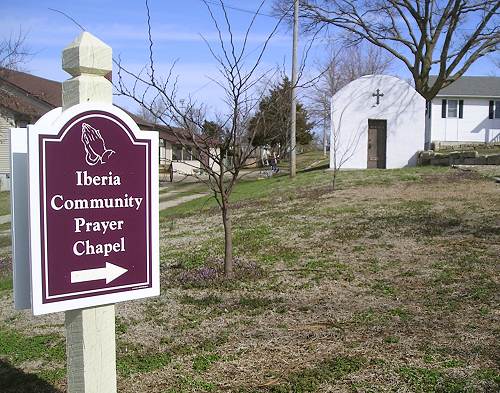
12 Iberia Community Prayer Chapel
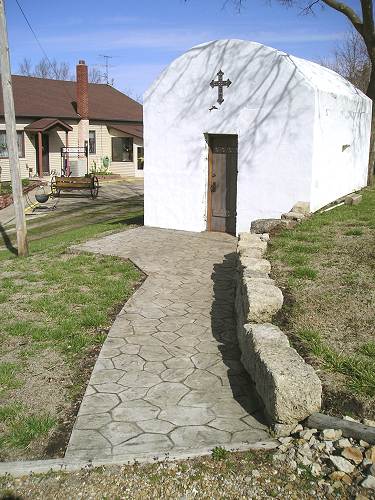
13 New Walkway
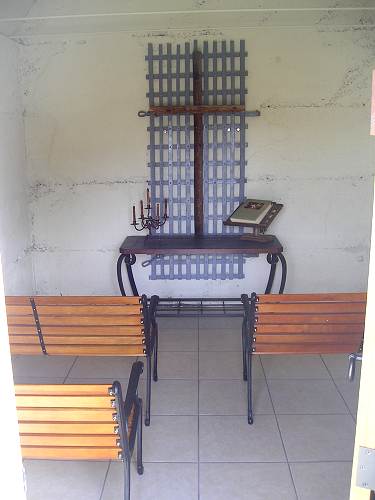
14 New Prayer Room I thought readers might want to read the history of the old jail as written by Peggy Hake copied from our website:
Iberia Jail
Peggy Hake
In 1908, David and Henrietta Farnham deeded a quarter-acre of land in Iberia to the trustees of the Iberia town board and an old jail was constructed on the site. It is still standing today on the same site and will soon be 100 years old. It is built of concrete and measures 12 by 14 feet… It was Iberia's first jail and was constructed circa 1910 by Harrison Smith and his sons. William Harrison Smith was my great-grandfather and his sons, Frank (my grandfather) and Felix (Pea), were well known stonemasons in the Big Richwoods of southern Miller County. They constructed many house foundations, fireplaces and other stone structures in the Iberia area over the late years of the 19th century and the early 20th century.
Rumor was that the old jail would be named after the first man imprisoned there, but the man and the crime seems to have passed unnoticed. It is simply called the Iberia jailhouse. When it was in use it contained a cot, a chamber pot, and a coal-burning King stove, which was maintained by the city marshal. Those I remember serving as town marshal included Barney Hutsler, John "Fount" Ahart, and Norwood Clark over the years.
I remember when I was a girl growing up in Iberia I passed by the old jail house many times as I walked up the hill to Iberia from our home in the area called "New Town." I have heard many stories told of fights and brawls that occurred on Saturday nights and the many folks who had to spend the night 'sobering up' before they were released the next day. I would imagine the nights were not limited to only Saturday, but probably other nights as well!
A few years ago someone decided to improve the looks of the old building and painted the outside with white paint…it still looks like an old jail house to me with its door still barred and a couple of small windows which filtered in some sunlight (photo 14a)!

14a Old Jail before Conversion I am sure that if the walls could talk, they could tell some interesting stories that happened inside the one-room cell block over the many years it has existed. The old building will remain as a historic landmark, situated near the Church of the Nazarene, on Main Street in the western section of the original town of Iberia on the old road that has been inventoried over the years as the Big Piney-Tuscumbia Road.
A few weeks ago I and Judy and Sharon, her sister, took their mother, Elva Boyd Steen over south of the river to the farm where the “County Poor Farm” had been located many years ago in the late 1800’s. The reason for going was to check on the status of the old home, surprisingly still standing, which was where the County sent the poor or sick who could not care for themselves. However, Elva also wanted to see the home once again because when she was a youth, she and her sister would walk from Ulman to the farm to visit a friend, Calvin Wyrick, who lived there. Calvin had been born there although the family (known as the Alvin Wyrick family) moved when he was young west of there to another farm on what is now F Highway. The farm has changed hands several times since Calvin lived there.
Here are four plat maps of the area (Plat T40N R14W S2) where the farm is located (photos 15, 16, 17 and 18).
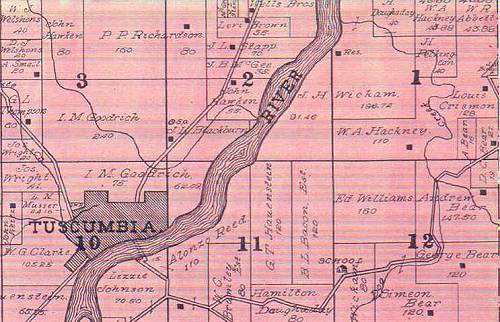
15 Section 2 - 1905
Click image for larger view
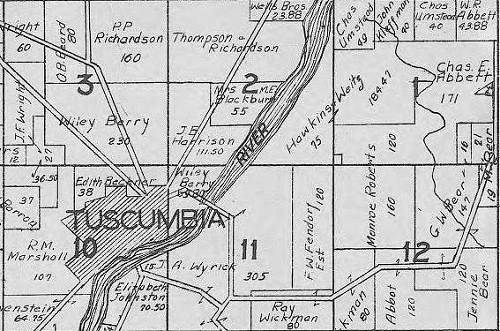
16 Section 2 - 1935
Click image for larger view
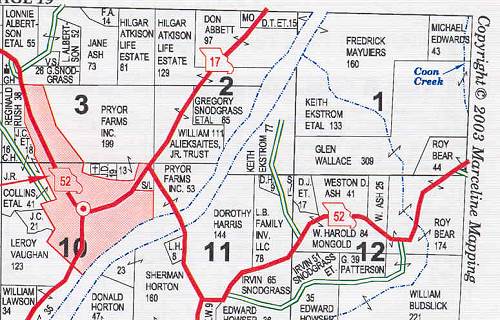
17 Section 2 - 2003
Click image for larger view
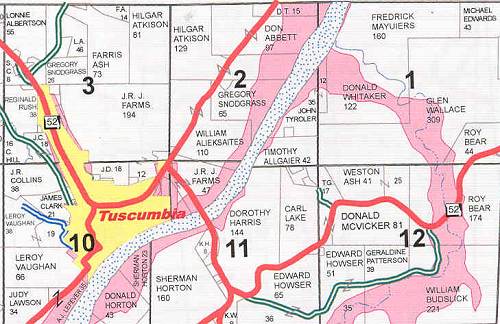
18 Section 2 - 2009
Click image for larger viewIn these maps, the farm can be found in the lower right corner of Section 2 on the south east side of the Osage River which the farm borders. In the plat maps you can see who the owners of the farm were during the year the map was drawn. Surprisingly, although Alvin and Calvin Wyrick lived there, these particular plat maps don’t contain the Wyrick name. Possibly, the Wyricks were renters and not landowners. The names which are recorded are: photo 15 J.H. Wickham; photo 16 Hawkins-Weitz; photo 17 Keith Ekstram; photo 18 John Tyroler.
Elva thought the house looked not very much changed even being so old. The home has a beautiful overlook of the Osage River below. Here is a photo taken from a distance of what originally was the Miller County Poor Folks Home (photo 19):
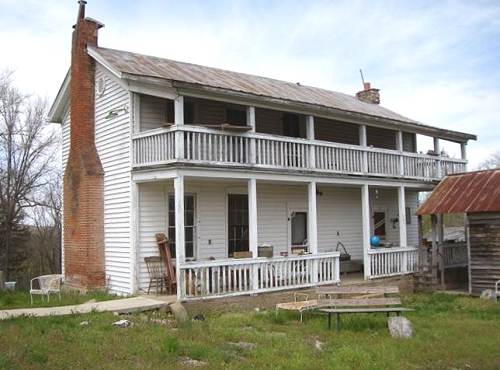
19 Poor Folks Home I discussed the Poor Folks Home earlier last January in this Progress Notes.
For convenience, I will copy here the part of that narrative having to do with the Poor Folks Home as written by Peggy Hake:
The Miller County Poor Farm
Windows From the Past
Peggy Hake
From Goodspeed’s “History of Cole, Moniteau, Morgan, Benton, Miller, Maries and Osage Counties,” written in 1889, page 543:
A farm of 215 acres was bought (by the county) in 1884 about a mile below Tuscumbia, on the right bank (south) of the river and W. A. (Wesley) Hackney became its first superintendent. It has several frame buildings and a few inmates under the care of J.E. (James) Walker.”
With those few words recorded over 100 years ago in Goodspeed’s History, the history of the county’s “poor farm” (also referred to as the “poor house”) had its unpretentious beginning. From 1884 through February 1888, Wesley A. Hackney was the overseer/superintendent of the poor farm which took in indigent people, who were called paupers in those days.
In November 1886, Wesley Hackney presented his bill to the county for a nine month period during 1886. The following is the contents of the court record:
Support for James Hesling, 9 months @ $50 per year, $45; Support for William Shackleford, 8 months a@ $100 per year, $66.66; Support for B. Smitty, 9 months @ $100 per year $75; Support for Elizabeth Martin, 6 months @ $60 per year $30; Support for Caleb Luttrell, 6 months @ $60 per year $15; Support for Charles Ellis, 3 months @ $60 per year $15; Support for Mathias Themline, 2 months @ $60 per year $10; Support for Ellen Burns, 2 months @ $60 per year $10; Repairs on house at poor farm $8; Total amount of bill $274.66. Credit county by amount heretofore paid by county $190; Credit county by rent of Poor Farm $200; Balance due County by Superintendent $115.33.
From the above bill presented to the county court by W.A. Hackney, it appears that he owed them money for keeping all these paupers during the nine month period. Evidently it was not a profitable business!
However, in February 1887, the county court made an agreement with W.A. Hackney to continue being the overseer of the poor farm. The contract in part stated:
“The court for and in consideration of services hereinafter mentioned grants, devised and lets to W.A. Hackney the following described premised in said county (Miller) and state (Missouri) for the period of one year beginning on the first day of February, 1887 to wit: “The County Poor Farm of said county situated on the Osage River at the mouth of Dog Creek…”. The said Hackney agrees to pay as the annual rents of said farm the sum of $200 and to keep up all fences and cultivate said farm in a husbandman like manner…The said Hackney agrees further that he will keep, feed, closthe, and maintain all county paupers required by the court to be kept on said farm at the following rates viz:
For all paupers as may remain on farm more than three months during year and for all paupers as heretofore classed as “Class A” at the sum of $25 per quarter…it is understood by all parties that said sums shall not be in lieu of medical treatment or funeral expenses of any pauper, which expenses shall in all cases be paid by said county if necessary and reasonable…not to exceed $10…said Hackney shall be entitled to the labor of paupers kept by him who are able to do manual labor and for that purposes authorized to use necessary coercion and discipline for the preservation of the health and cleanliness of such paupers.”
The second overseer as superintendent of the Miller County Poor Farm was James E. Walker, who took over the duties in 1888 from Wesley A. Hackney. He remained the overseer for a few years.
The farm then was sold to the Wyrick family. James Alvin Wyrick and his wife, Sarah J. (Vannata), reared several children on the farm including
1. Oliver Churchill Wyrick
2. Grace Wyrick (Mrs. Claude Martin)
3. Vivera Ocra Wyrick (Mrs. Ross Adcock)
4. Calvin T. Wyrick
5. Homer Wyrick
6. Ray Wyrick
7. Clay Wyrick
8. Clarence Wyrick
Calvin Wyrick and his family lived on the farm until about 1977 when it was sold to Mr. and Mrs. Keith G. Ekstrom, who are the present owners. The Ekstroms have begun renovating the old two story house, which is rich in history. I was privileged to visit with them recently and be shown the unique construction of the house complete with a winding stair case to the upstairs rooms, original windows, facings and ornate trim.
(Note: The house was sold subsequent to when Peggy visited).
On the property is an old cemetery which has been inventoried as the “Birdsong Cemetery.” It is near the homestead and has some very old grave sites in its boundaries. The oldest known grave is for Benjamin F. Birdsong (1822-1851), a son of Josiah and Nancy (Huddleston) Birdsong. In the cemetery can be found other members of the Birdsong family. Other names are Richardson, Abrams, Lurton and Dayton.
Without seeing an abstract to the land, I have to presume that the Birdsong family were early residents of the property since the old cemetery is located so near the house that later served as the county’s “poor farm.”
A few weeks ago I had the opportunity to photograph some of the old horse drawn farm equipment owned and used by Willard Boyd on his farm near Ulman back in the 1920’s,30’s and 40’s.
The last farm on which Willard and his wife, Maggie lived was the old Peter Lupardus place where the Boyds’ lived in the old cabin Peter had built back in the mid 1850’s (photo 19a).
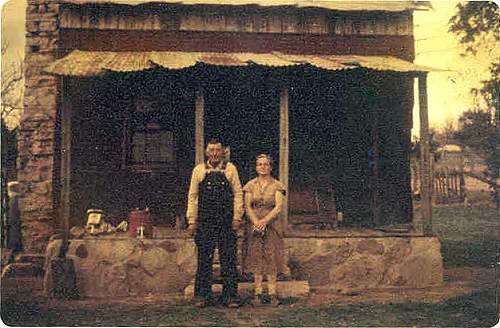
19a Willard and Maggie Boyd This old cabin was carefully disassembled and moved to our museum grounds in the mid 1990’s by members of the McDonald family and other descendents of Peter Lupardus. I have discussed the details of this event in an earlier Progress Notes.
As I noted in that earlier narrative, Willard and Maggie were the parents of Elva Boyd, my mother in law, who presently helps us with our quilting program. My wife and her sisters spent many days and nights around and in the old log structure. After it was disassembled my sister in law, Sharon Steen Holder, was given some of the old farm horse drawn equipment from the farm and it was at her present home where I took these photos (photos 20, 21 and 22).
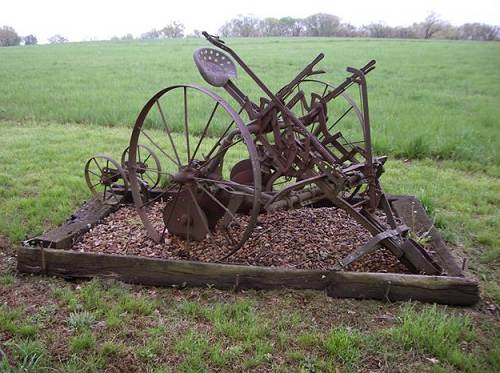
20 Disc
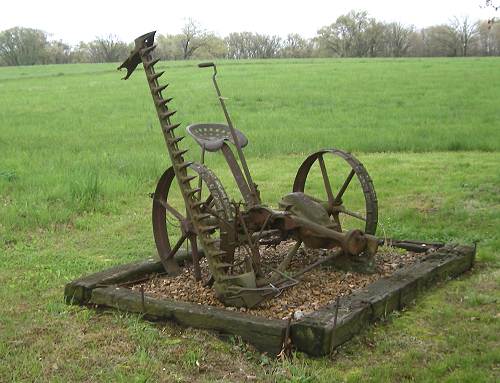
21 Mower
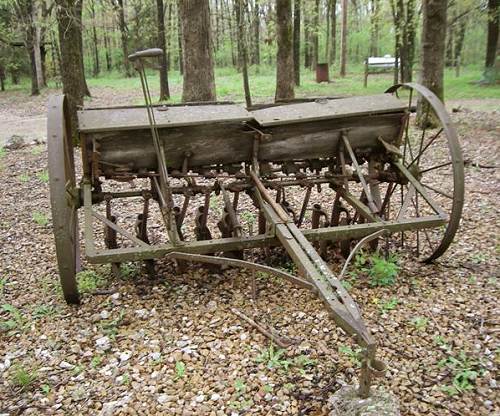
22 Planter Other items saved by Sharon were the old limestone doorstep to the cabin (photo 23), the old porch lantern (photo 24), the old Boyd mailbox (photo 25), and an old milk can (photo 26).
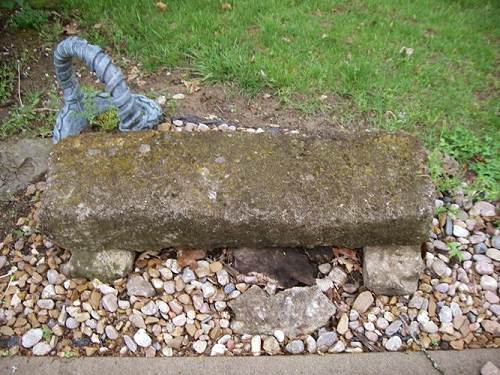
23 Door Step to Lupardus Cabin
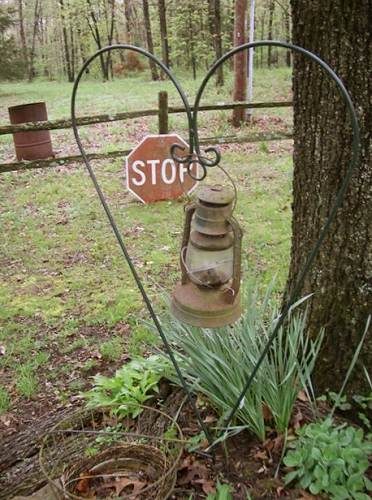
24 Porch Lantern
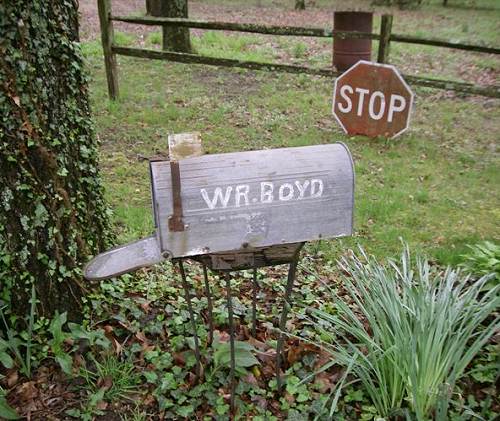
25 Boyd Mailbox
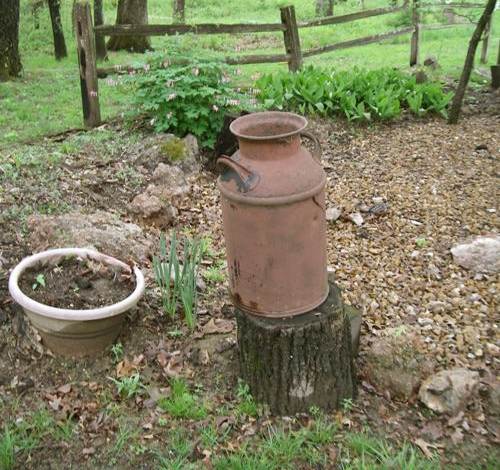
26 Milk Can The horse drawn equipment in the previous photos which were owned by Willard Boyd were all he used for working his farm. He never owned a tractor, or a car for that matter. He usually kept a team of mules for the farm work but also had a saddle horse for going in to town.
Although I had a saddle horse as a boy I never harnessed or drove a team. Many of the older readers of this site, however, I am sure had that opportunity frequently on their own farms growing up. For those who never worked with a team of horses or mules I found a website with photos and short descriptions of how to harness a team. These are modern photos and the equipment appears to me more involved and elaborate than that used in days past. But the photos give an idea of what it is like to harness a team:
Harnessing a team
http://www.cowboyshowcase.com/harness.htm
Harnessing Sequence
Harnessing draft horses is virtually becoming a lost art. This is due to the lack of work for teams because hauling and farm and ranch work has become mechanized since the advent of the automobile. Here is the way Chris Hone harnesses the Diamond Z Hitch teams for his parades and shows.
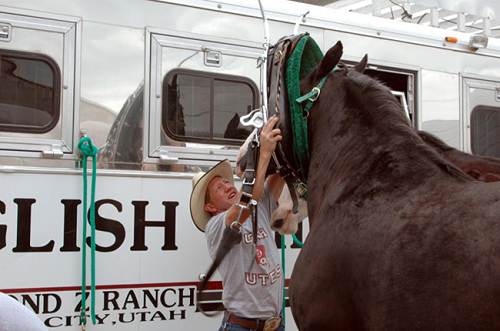
27 Chris Hone puts collar and attached hames over the head. The horses are trained to stand untied.
Most people will need to unhook the collar and place it around the horse’s neck instead of over the head.
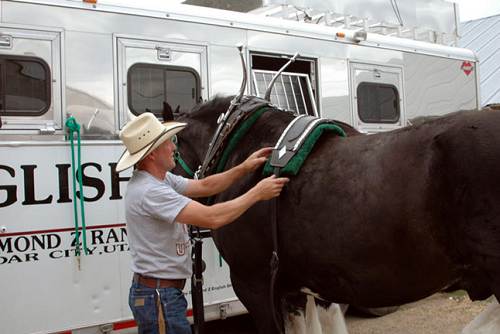
28 Back straps
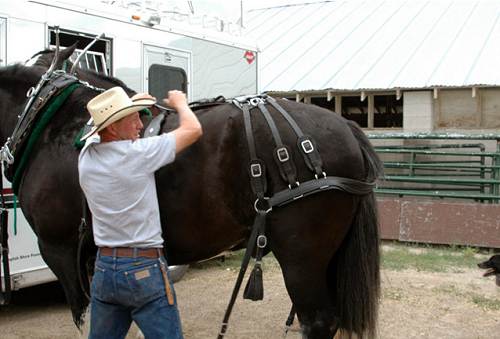
29 Britchen - hook into back straps. Britchens are used on the wheel team (team next to the wagon),
the larger sized horses are normally used on the wheel team because they have to hold back more weight.
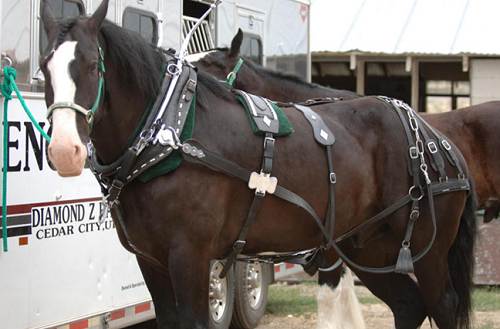
30 The britchen is hooked to pole straps and neck yoke straps.
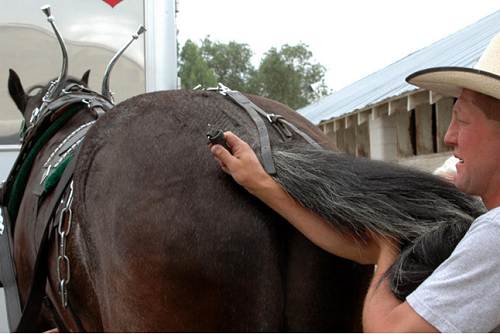
31 No britchens are used on the lead teams. They use croupers instead.
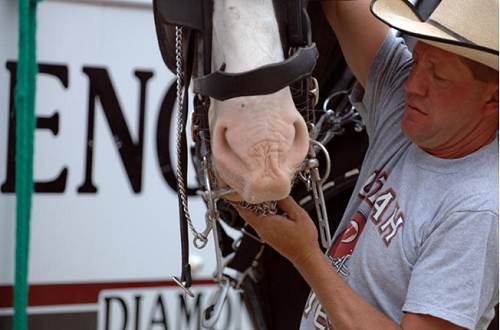
32 Bridles are placed on the horses. The horses are standing untied.
They use a Liverpool straight-shank bit with check straps
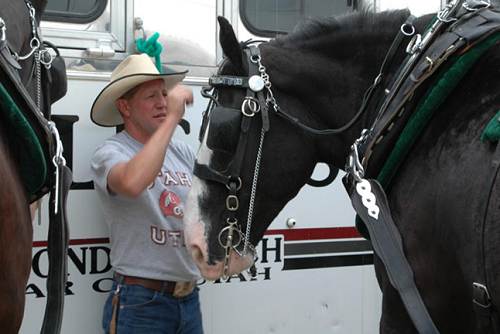
33 Bridle and check straps behind the ears and head.
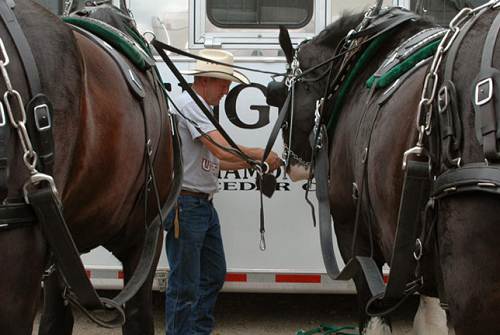
34 Heart rings—used to keep the driving reins straight between the horses.
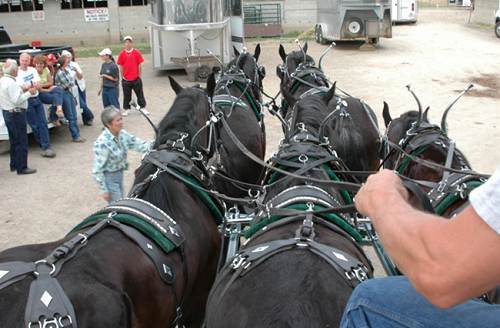
35 Overview from the driver’s seat -- the horses hooked up and ready to drive.
Another website I found was written by a southeastern Missouri farmer who described his experience with a team of horses:
Jack Eugene Middleton
http://www.toflyagain.org/Summer%20Jobs.htm
Another job of antiquity that I remember as a youth was the time I plowed a 3 acre lot with a team of mules. Now that may not seem like much today….but those mules were BIG and the plow was HEAVY.  Mules are not known for their good nature, but the pair which the farmer borrowed for the job were friendly enough. Handling a plow, keeping it upright, walking on the ground as it is being turned, having the reins of the team draped around your neck, while shouting "Giddi Up" or "Gee" or "Haw" or "Whoa" is no small feat for a 14 year old boy. Clue…. don’t bend the mules ears when you put on the bridle… Another clue…. always watch the hind feet and try to keep your distance! You may have heard the saying “It kicks like a mule”. That is not only colorful, it means a lot to anyone who has worked with them. Mules are not known for their good nature, but the pair which the farmer borrowed for the job were friendly enough. Handling a plow, keeping it upright, walking on the ground as it is being turned, having the reins of the team draped around your neck, while shouting "Giddi Up" or "Gee" or "Haw" or "Whoa" is no small feat for a 14 year old boy. Clue…. don’t bend the mules ears when you put on the bridle… Another clue…. always watch the hind feet and try to keep your distance! You may have heard the saying “It kicks like a mule”. That is not only colorful, it means a lot to anyone who has worked with them.
And another site by a fellow from Kansas gives more information about handling a team. I always knew what the words Gee and Haw were used for but this gentleman makes the explanation entertaining:
James Lloyd Clark
http://faithmemories.com/hawgee.htm
Most dictionaries define the phrase, "To Haw And Gee", or "To Gee And Haw", in the following manner:
"To go from one thing to another without good reason; to have no settled purpose; to be irresolute or unstable. [Colloq.]"
When a person flits from one thing to another like a moth, or changes their mind over and over or seemingly has no purpose or destination in mind they are said to haw and gee or to gee and haw. I have heard someone describing another by saying "They don't know whether to haw or gee". When I was a child, I was very familiar with the phrase, to Haw and Gee or Gee and Haw.
I am not certain of the country of origin of the two words Gee and Haw, but I have heard them used many times when I lived in the farm country of Southeast Missouri. Most farmers in that area used horses to pull plows, discs and other machinery while doing farm work and the horses needed to understand some sort of horse commands in order to follow the farmer's instructions. Tractors were scarce in the 1930s and early 1940s. I have seen my Dad plowing or doing other work with a team of horses and when the plow reached the end of the row I could hear my Dad call out "Haw" if he wanted the horses to turn left and he would call out "Gee" if he wanted the horses to turn right. The horses understood those horse commands and usually obeyed them. Horses, even work horses, are intelligent enough to obey commands if they have been taught well.
It is my understanding that the horse command, Haw, in it's strictest sense, means turn toward the driver and the command, Gee, means turn away from the driver. Drivers of teams in England walk on the right side of the team but drivers of teams in the United States walk on the left side of the team. The command, "Haw" in England would turn the horse to the right but in the United States "Haw" would send the horse to the left. Generally, work horses are not subject to a lot of international travel so the fear of great confusion on the farm is minimal. I recently watched a Amish farmer near Shipshewana, Indiana who was plowing with a team of beautiful Belgians, 6 horses abreast, and when he came to the end of the field, and stopped, he called out what sounded like "Hah" and the team turned left, with uniform precision. The Belgian at the radius center took very small steps and the horse out near the end of the arc took full steps. These Belgian Horses were powerful and smart too.
In today's world we see many people who seemingly don't know whether to Haw or to Gee. People are confused as to what is right and what they should do. Many don't even care what is right, they just want to follow their own whims or desires for the moment and may not have a clear destination in mind. We hear about "those on the right" and we hear about "those on the left" and we hear about being politically correct. Many of those who consider themselves to be on either the left or the right probably still don't know what they really believe down deep in their hearts. They are following a man or a slogan or whatever sounds or smells good at the time but when push comes to shove, they don't know whether to haw or gee. Many of them just don't hear the commands. I have heard my Dad speak of someone who was having a lot of trouble making up their mind about something, first leaning in one direction and then the other, as "They are just Gee Hawin' around". Sometimes Dad used that phrase to describe someone who was always "horsing around", if I may make a play on words, and he would say, "Oh they're always just Gee Hawin' around". Sometimes Dad added a few other comments too.
The following is an announcement I sent to the local papers last week:
Oil Painting of R.S. Harvey Donated To Museum
The Miller County Historical Society was greatly honored this week by the donation from Bill Harvey of Eldon of a painting of his great great uncle Robert S. Harvey (photo 36).
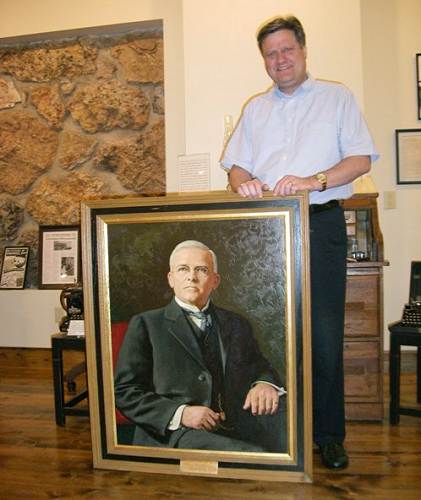
36 Bill Harvey with painting of Great Great Uncle R.S. Harvey The oil portrait had been painted in the 1920’s and first was placed in the old Harvey Bank building at First and Maple in Eldon. Later the portrait was hung in the Bank of Eldon when it was built on Oak Street in the 1960’s and later was placed in the Mercantile Bank when it was built a block south. When US Bank bought the Mercantile bank the portrait was returned to the family and placed in the care of Bill Harvey. Robert S. Harvey is recognized as being one of the most important figures in the early history of the growth and development of Eldon. We at the museum are very proud and grateful that the Harvey family has designated our museum to be the recipient of this historical painting. It is now prominently displayed in the new addition of our museum in Tuscumbia (photo 37).
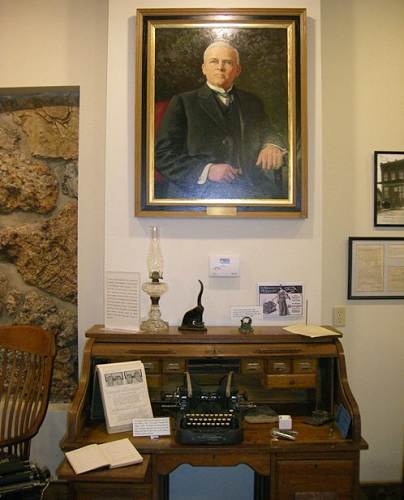
37 R.S. Harvey Portrait The following about Bill as well as the Harvey family recently was printed in the Vernon Publishing Company newspapers:
The Miller County Autogram-Sentinel
Thursday, Feb.12, 2009
Bill Harvey
BY GINNY DUFFIELD
Bill Harvey may be one of the newer faces at the courthouse but his roots are deep in Miller County. Harvey was appointed late last year to be Miller County collector, replacing Larry Sullivan who resigned due to health reasons. He spent December and January trying to learn the job during the busiest time for the office, tax collection season. Recently, he had time for an interview.
Harvey was reared in Eldon, the son of the late Herb and Bonnie Harvey and one of four children. He said he has lived in Eldon all of his life, except for his college years. He holds a degree in finance from what is now known as Missouri State University in Springfield.
Like many young people preparing to strike out on their own, he thought he would leave his hometown.
“I kind of thought in my mind I wanted to work in a midsize city,” Harvey said.
Summer jobs at Mercantile Bank of Eldon had helped him on his career path, Harvey said. Earlier summer jobs had meant lots of manual labor. Harvey’s parents owned and operated Eldon Hardware and Lumber Company for much of his childhood and teen years. “The first job I ever had was at Eldon Hardware and Lumber Co.,” Harvey said. He worked there four summers. He said the hardest day he ever had was helping haul Sheetrock off the delivery truck and down a steep hill for about 30 feet at the lake. The wallboard had to be carried one sheet at a time and dropping one would have meant it going off the steep hill.
That may have ended childhood fascination with the lumber business. “Dad, take me to the lumberyard. I want to see the big trucks,” was a frequent refrain from a younger Bill.
Harvey has lots of praise for Jerry Setser, a longtime Bank of Eldon (which became Mercantile Bank and went by several other names before becoming US Bank in Eldon several years ago) employee and eventually its top manager. While working at the bank after graduation, “I kind of fell in love with the town again,” Harvey said.
“Jerry said, “We’d like you to stay.”
And he did stay, for 22 years.
“The best boss I ever had in my life was Jerry Setser,” Harvey said. He said he found him to be wise, kind and fair and that he told his employees to do their job with dignity and to treat people with dignity.
“I always tried to do that. It’s been a good lesson.”
Harvey said he intends to continue that philosophy as collector.
That philosophy and his experience in small-town banking help with his current career. Banking is a retail business with the goal of making a profit. The collector does not make a profit but is still serving the public, Harvey said.
“Customer service is highly important. We don’t have stockholders to answer to, we have customers.”
“We do all we can to make things as simple as possible,” Harvey said.
But the staff has to follow state law and if they don’t, they are breaking it. The staff can’t let a penalty slide for late payment of taxes, even if it’s only a day.
“It’s your responsibility to find out if there’s taxes owed and when the taxes are due,” Harvey said about property owners, particularly those who have recently purchased property because the tax bill may go to the former owner.
After leaving the bank in Eldon, Harvey was with First Bank at the lake for three years but he was tired of banking and was looking for a career change. Harvey said the staff at the collectors office is “fantastic” and have helped him get to know the job.
“I saw the tough stuff right off the bat,” he said. For the last one and a half weeks of 2008, “We had people 10 deep in three lines,” Harvey said. Some people had to wait 20 to 30 minutes to pay their taxes.
“They worked their butts off and took their job seriously,” Harvey said about the staff in the office.”
“We did take longer than normal getting December (the monthly
report) done because I was new,” Harvey continued.
Harveys and Miller County
“We mostly felt like we were in the lumber business,” Harvey said about his family. A large, two-story brick building on Maple Street in Eldon housed that family business, beginning in 1891. Hardware was on the main floor of Harvey Mercantile and the lumber yard was to the west, where city offices are now.
“The name of that business (the lumberyard) has changed here and there,” he said. Henry Phillips and N.E. “Ed” Harvey were in business together. As was common in the 1800s and early 1900s, the lumberyard provided coffins and therefore they were in the funeral business, too.
“Things went well and they amicably split it up,” Harvey said. Phillips Funeral Home resulted along with Eldon Lumber. “The Harveys and Phillipses have been very close for over 100 years. Still are,” Harvey said.
The mercantile was selling everything from nails to ladies’ shoes. “It was kind of a general store,” Harvey said. Gradually, the business model changed and the hardware moved to the lumberyard area in 1941.
Harvey’s grandfather, Harry Harvey, earned an electrical engineering degree in college, having attended Westminster and Stanford.
“He and N.E. got the electricity started in Eldon,” grandson
Bill said. The power plant was near where Gerbes is now in Eldon.
Eventually the providing of electricity was sold to a forerunner of
AmerenUE.
Bill Harvey’s father Herb returned to Eldon after college and service in World War II, joining the business in 1949. In 1972, Herb was facing an illness doctors told him would lead to his death within two years. Looking for a partner, he settled on Howard Vann, although as Bill remembers Vann, who was established in a career, took some convincing. “My father recollects Howard was reluctant to get into the business,” Harvey said.
Herb Harvey actually lived 13 years after his doctors gave him the bad news. Vann remained owner of Eldon Hardware and Lumber as it was relocated to Fifth Street where the former Anchor Milling
Company was located. When he retired, the business was sold to
Hermann Lumber, which continues to operate it.
Another branch of the Harvey family provided the historical connection to Bank of Eldon. R.S. Harvey, Bill’s great-great-uncle, started it in 1895. The charter is framed and in Bill’s office. The original building, located at the corner of Maple and First streets in Eldon, still carries the R.S. Harvey name on its escarpment two stories above the street.
While Bill Harvey is new to politics, R.S. was strongly interested in politics, and not just local politics. He was a Republican delegate to the 1900 national convention in Philadelphia.
That Harvey also “was very involved with the railroad,” Bill Harvey said. His tie operation rafted ties from the Bagnell area to Tuscumbia, where they were delivered to track building operations by horse and mule-drawn wagons. “He was successful in business,” Bill Harvey says about R.S. But he donated to the community too, including land for U .S .Highway 54; McMillen Field, located next to the Miller County Fairgrounds; and for the Eldon First Christian Church. “I’m proud of my history. It’s something I can never live up to,” Harvey said.
His family
Harvey and his wife Sheri, a graduate of Eldon High School, have been married 21 years. “She’s my rock, no doubt about it.” They have a daughter Allie, 18, who is a senior at Eldon High School and plans to attend Lincoln University to become a nurse; and a son, Will, 12, a sixth grader “very interested in skateboarding, Guitar Hero and all sports.”
Coincidently, Mrs. Harvey is a tax collector too, working for the
Missouri Department of Revenue, a job she has had for 24 years. “I enjoy golf and cooking,” Harvey said. He added his chili and spaghetti sauce are his best dishes. “We split about 50-50,” he said about sharing cooking chores.
The family lives in a house that was home to grandfather Harry and grandmother Marian.
“My Dad actually designed that house,” Bill said, noting that
Herb had intended to become an architect. “We’ve still got the
Original plan,” Bill said.
When his grandparents and parents were still alive, they actually lived across Newton Street from each other. Bill said it was neat for his son to learn to ride his bike on the same street as he did.
Marian Harvey was well-known as a piano teacher and her grandson said he does not think she ever charged more than $1 for a lesson.
“I took lessons. She never pushed.” But, like so many youngsters, he did not stay with it. He started again for a time at age 21 but said he is not a piano player.
Bill Harvey’s sister and older brother Harry live in Phoenix. His other brother, Jim, lives in Jeff erson City and is well known in the area lumber industry as he is a sales man and calls on many lumberyards in the central Missouri area.
Also last week we enjoyed the visit of Morgan and Connie Pope who have lived for many years near Portland, Oregon (photo 38).
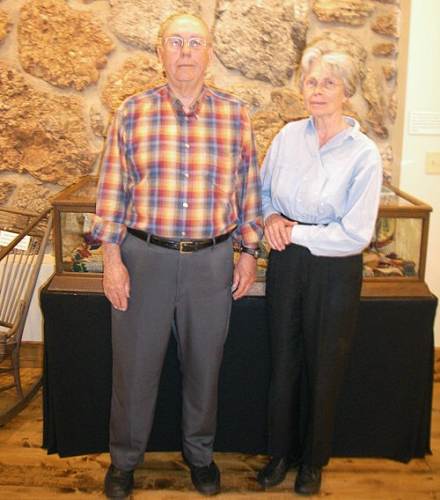
38 Morgan and Connie Pope Morgan is a graduate of School of the Osage who had returned to the area for the annual Osage High School Reunion. You can read the very interesting story about Morgan and his family which was featured on our website last year.
Morgan is very interested in the genealogy of his Sullivan, McDowell, Lupardus and Pope roots in the area. He especially enjoyed on this trip revisiting the site of the home of his great grandfather, Greenberry Pope.
Preparations are continuing for our Grand Reopening on Saturday, May 16 beginning at 1:00 p.m. with a flag raising ceremony and official ringing of the old Tuscumbia Presbyterian Church bell followed by the introduction of our area government officials: County Comissioner Tom Wright, State Representative Rodney Schad, State Senator Carl Vogel, and U.S Representative Blaine Luektemyer.
Our museum staff and surrounding community were very saddened recently about the death of Jerry Thompson of Jefferson City. Jerry was the husband of our very beloved museum director, Nancy Thompson. The death was unexpected as it was the result of an accidental fall causing a severe head injury. Jerry, a very personable and likeable fellow, was well known to all of us at the museum. The memorial service was held Sunday, April 26, at the Dulle-Trimble Funeral Home with Pastor Grant Foster officiating. Copied below is the obituary provided by the family:
THOMAS GERALD THOMPSON
April 16, 1936 - April 21, 2009
Jefferson City, Missouri
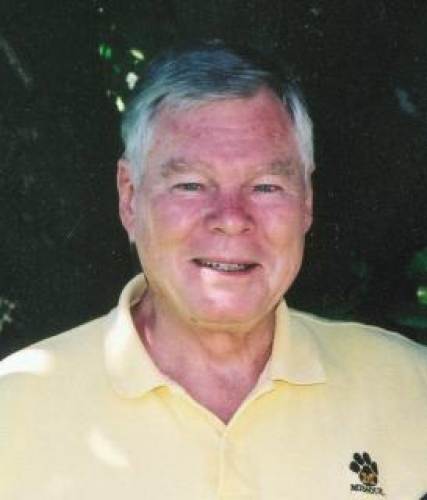
39 Jerry Thompson Thomas Gerald “Jerry” Thompson, 73, of Jefferson City, died Tuesday, April 21, 2009, at Adams Street Place. He was born on April 16, 1936, in Dierks, Ark., the son of Marvin Gerald and Jennie Mae Wisener Swift. In 1942, his mother married Joseph Roy Thompson who legally adopted and raised Jerry. He was united in marriage on July 5, 1958, in Hernando, Miss., to Nancy Sue Arnold who survives at the home.
Jerry graduated from the University of Missouri in 1961, with a Bachelor of Science degree in Business Administration. He was an avid fan of Mizzou sports and loved football. He was employed by Mobil Oil Company and Buick Division of General Motors before joining Winnebago Industries where he became Vice President of Sales and Marketing. He later worked for Airstream, as Vice President of Sales and Marketing. He was employed by Paxton Lumber Company of Kansas City and managed their yards in New Orleans, La., Cincinnati, Ohio.
Other survivors include: one daughter and son-in-law, Melissa Cay and Andy Piccolo, Gainesville, Ga.; two sons and daughters-in-law, Thomas Grant and Becky Thompson, Monroe La.; Jeffrey Lynn and Amy Thompson, Camdenton; 15 grandchildren; several foster grandchildren; and two brothers, Bill Thompson; Jefferson City; and Doug Thompson, Blacksburg, Va.
He was preceded in death by his mother, father, step-father, and a grandson, Ben Thompson.
A memorial service will be 3 p.m. Sunday, April 26, 2009, at Dulle-Trimble Funeral Home with Pastor Grant Foster officiating.
Visitation will be 2-3 p.m. Sunday at the funeral Home.
Memorials are suggested to the Miller Co. Historical Society, Tuscumbia, Mo; or to a charity of the donor’s choice.
Those wishing to email condolences to the family may do so at the www.dulletrimble.com website.
That's all for this week.
 Joe Pryor
|



